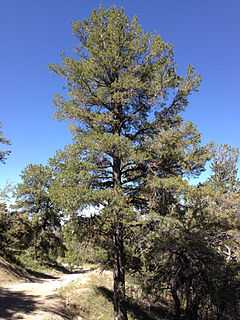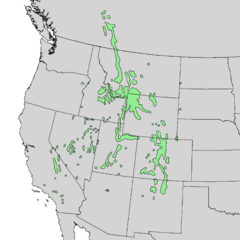Pinus flexilis
| Limber pine Pinus flexilis | |
|---|---|
 | |
| Limber pine on Spruce Mountain, Nevada | |
| Conservation status | |
| Scientific classification | |
| Kingdom: | Plantae |
| Division: | Pinophyta |
| Class: | Pinopsida |
| Order: | Pinales |
| Family: | Pinaceae |
| Genus: | Pinus |
| Subgenus: | Strobus |
| Species: | P. flexilis |
| Binomial name | |
| Pinus flexilis E.James | |
 | |
| Natural range of Pinus flexilis | |
Pinus flexilis, the limber pine, is a species of pine tree-the family Pinaceae that occurs in the mountains of the Western United States, Mexico, and Canada. It is also called Rocky Mountain white pine.
A limber pine in Eagle Cap Wilderness, Oregon has been documented as over 2000 years old, and another one was confirmed at 1140 years old.[2][3] Another candidate for the oldest limber pine was identified in 2006 near the Alta Ski Area in Utah; called "Twister", the tree was confirmed to be at least 1700 years old and thought to be even older.[4]
Description
P. flexilis is found in the subalpine areas of the Rocky Mountains from southwest Alberta Canada south through Colorado and New Mexico into the northern states of Mexico; from mountains in the eastern Pacific Northwest states through the Great Basin states of Nevada and Utah. It is also found in California: in the Eastern Sierra Nevadas; the eastern California White Mountains; and the Southern California San Bernardino Mountains and San Gabriel Mountains of the Transverse Ranges. Continuing south the species is found in the San Jacinto Mountains, Santa Rosa Mountains, and Hot Springs Mountain of the Peninsular Ranges; and a small disjunct population in the Black Hills in South Dakota.[5][6]
P. flexilis is typically a high-elevation pine, often marking the tree line either on its own, or with whitebark pine (Pinus albicaulis), either of the bristlecone pines, or lodgepole pine (Pinus contorta). In favourable conditions, it makes a tree to 20-meter (66 ft), rarely 25-meter (82 ft) tall. However, on exposed treeline sites, mature trees are much smaller, reaching heights of only 5-meter (16 ft) - 10-meter (33 ft).[5] In steeply-sloping, rocky and windswept terrain in the Rocky Mountains of southern Alberta, limber pine is even more stunted, occurring in old stands where mature trees are consistently less than 3m in height.[7]
Related species
P. flexilis is a member of the white pine group, Pinus subgenus Strobus, and like all members of that group, the leaves ('needles') are in fascicles (bundles) of five, with a deciduous sheath. This distinguishes it from the lodgepole pine, with two needles per fascicle, and the bristlecone pines, which share five needles per fascicle but have a semi-persistent sheath.

Pinus albicaulis
Distinguishing limber pine from the related whitebark pine (P. albicaulis), also a white pine, is very much more difficult, and can only easily be done by the cones. In limber pine, the cones are 6-centimeter (2.4 in) - 12-centimeter (4.7 in) long where the species overlap, green when immature, and open to release the seeds; the scales are not fragile. In whitebark pine, the cones are 4-centimeter (1.6 in) - 7-centimeter (2.8 in) long, dark purple when immature, and do not open on drying, but are fragile and are pulled apart by birds (see below) to release the seeds.[8] A useful clue is that whitebark pines almost never have intact old cones lying under them, whereas limber pines usually do. [9]
Pinus monticola
In the absence of cones, limber pine can also be hard to tell from Western white pine (P. monticola) where they occur together in the northern Rockies and the Sierra Nevada east slope. The most useful clue here is that limber pine needles are entire (smooth when rubbed gently in both directions), whereas Western white pine needles are finely serrated (feeling rough when rubbed gently from tip to base). Limber pine needles are also usually shorter, 4-centimeter (1.6 in) - 7-centimeter (2.8 in) long, to Western white pine's 5-centimeter (2.0 in) - 10-centimeter (3.9 in) (though note the overlap).
Diseases
Limber pine is susceptible to white pine blister rust, caused by Cronartium ribicola, a fungus that was introduced accidentally from Europe. Limber pine mortality is high in many areas throughout its range, except Arizona, where it has not yet been found. However, there is little hope of controlling the blister rust in existing trees. Research is under way, locating and breeding from the occasional naturally resistant limber pines, and by studying the resistance mechanisms of the European and Asian white pines (e.g. Swiss pine, Macedonian pine), which are strongly resistant to the disease.
Cultivation
The popular cultivar P. flexilis 'Vanderwolf's Pyramid' is widely available as an ornamental tree for gardens. 'Vanderwolf's Pyramid' derives from P. reflexa, though it is usually listed in nursery catalogs under P. flexilis.
The Southwestern white pine is popular as a windbreak tree or an ornamental tree due to its drought tolerance. It is also grown as a Christmas tree, liked for the soft needles but with stiffer branches than an Eastern white pine.
Wildlife

P. flexilis, is an important source of food for several species, including red squirrels and Clark's nutcrackers. American black bears may raid squirrel caches for limber pine nuts. Squirrels, Northern flickers, and mountain bluebirds often nest in the trees.
References
- ↑ Conifer Specialist Group (1998). Pinus flexilis. 2006. IUCN Red List of Threatened Species. IUCN 2006. www.iucnredlist.org. Retrieved on 12 May 2006.
- ↑ "Old Tree". Oregon Field Guide. 2010. Retrieved 2010-02-21.
- ↑ Richard, Terry (September 24, 2012). "Ancient limber pine, likely Oregon's oldest living tree, draws twin brothers to Wallowas quest (photo essay, video)". The Oregonian. Retrieved 2015-02-18.
- ↑ "Stay Flexible, Grow Old". BYU Magazine. Spring 2007. Retrieved 2015-02-18.
- ↑ 5.0 5.1 Moore, Gerry; Kershner, Bruce; Tufts, Craig; Mathews, Daniel et al. (2008). National Wildlife Federation Field Guide to Trees of North America. New York: Sterling. p. 81. ISBN 1-4027-3875-7.
- ↑ "Pinus flexilis". Flora of North America. efloras.org.
- ↑ Letts, M.G.; Nakonechny, K.N.; Van Gaalen, K.E.; Smith, C.M. (2009). "Physiological acclimation of Pinus flexilis to drought stress on contrasting slope aspects in Waterton Lakes National Park, Alberta, Canada". Canadian Journal of Forest Research 39 (3): 629–641. doi:10.1139/X08-206.
- ↑ "Pinus subgenus Strobus". Michael P. Frank's Cone Collection. Arboretum de Villardebelle.
- ↑ Roady, Laura. "Whitebark Pine". Montana Outdoors. Montana Fish, Wildlife & Parks. Retrieved 15 March 2015.
Further reading
- Chase, J. Smeaton (1911). Cone-bearing Trees of the California Mountains. Chicago: A. C. McClurg & Co. p. 99. LCCN 11004975. OCLC 3477527. LCC QK495.C75 C4, with illustrations by Carl Eytel - Kurut, Gary F. (2009), "Carl Eytel: Southern California Desert Artist", California State Library Foundation, Bulletin No. 95, pp. 17-20 retrieved Nov. 13, 2011
External links
| Wikimedia Commons has media related to Pinus flexilis. |
- USDA Plants Profile: Pinus flexilis (Limber pine).
- Gymnosperm Database: Pinus flexilis
- Flora of North America: profile and map - Pinus flexilis
- Pinus flexilis —Jepson Manual Treatment — Calif. distribution: High Sierra Nevada, Transverse Ranges, Peninsular Ranges, east of Sierra Nevada, Mojave Desert mountains.
- Pinus flexilis cone photos
- High Elevation White Pine Educational Website: Pinus flexilis
- Old Tree Documentary produced by Oregon Field Guide
